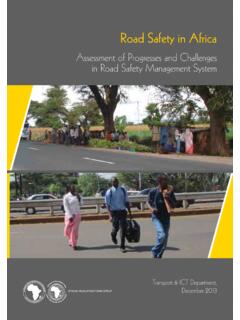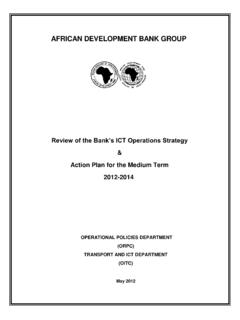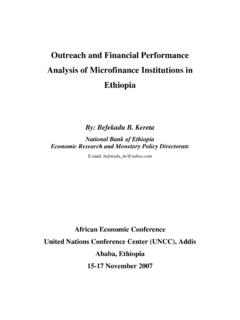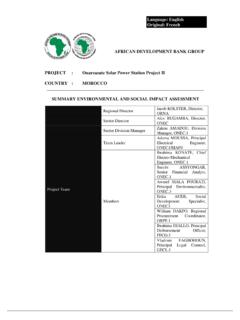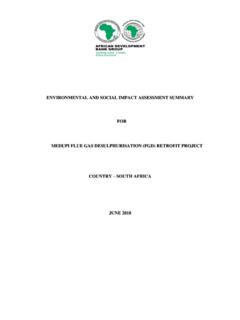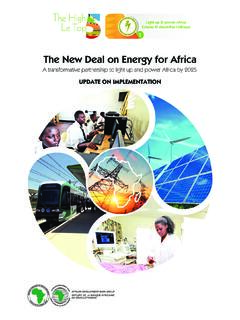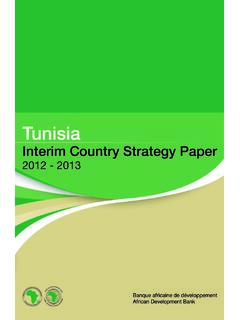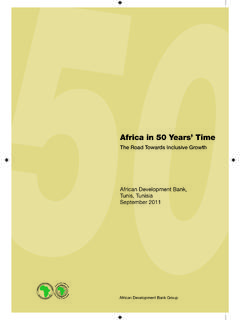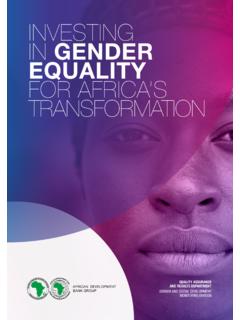Transcription of PROJECT: PROPOSED SOLAR POWERED PUMPING SYSTEMS …
1 1 Language: English Original: English PROJECT: PROPOSED SOLAR POWERED PUMPING SYSTEMS FOR IRRIGATION PROJECT COUNTRIES: SUDAN ESMP SUMMARY FOR THE PROPOSED SOLAR POWERED PUMPING SYSTEMS FOR IRRIGATION PROJECT Date: March 2019 Preparation Team Team Leader: A. WUBESHET-ZEGEYE, Chief Power Engineer, RDGE1 E&S Team Members: KAHUBIRE, Social Development Officer, RDGE4 /SNSC 2 PROJECT TITLE: PROPOSED SOLAR POWERED PUMPING SYSTEMS FOR IRRIGATION PROJECT PROJECT NUMBER: P-SD-FF0-001 COUNTRY: SUDAN CATEGORY: 2 Sector: PICU Project Category: 1 3 1.
2 INTRODUCTION Sudan is largely dependent on imported fossil fuels for power generation. Hence, there is an urgency to implement Sudan s Renewable Energy Master Plan (REMP) and reduce Sudan s dependence on fossil fuel. Sudan has abundant wind and SOLAR resources, but largely lacks the capacity to utilize these resources for power generation. Aprogramme to provide grid-connected electric pumps to replace diesel has been launched by the Ministry of Water Resources and Electricity (MWRIE) together with the Northern State Government to promote electric PUMPING for large scale farms (with an area of 100 ha or more). The SOLAR POWERED PUMPING SYSTEMS for Irrigation Project s intended goal is to use SOLAR water pumps for irrigation to replace either diesel -generated electricity or grid based electricity generation for water PUMPING for irrigation.
3 The replacement of the diesel pumps is going to generate certain climate related impacts. A diesel generator emits CO2 during operation and grid based electricity is usually generated with coal, oil or natural gas which also emits considerable quantities of CO2. In contrast, a SOLAR -based water pump system does not result in greenhouse gas emissions. Extensive use of SOLAR water pumps in irrigation would therefore lead to substantial greenhouse gas emission reductions. The main development objective of the project is to reduce the dependency on imported fossil fuels through the adoption of renewable energy for water supply in irrigation to foster economic and social development by increasing crop production in the agricultural areas around the country and promote peaceful environment for water resources use.
4 Some of the main features of the SOLAR POWERED PUMPING SYSTEMS for Irrigation are: i) The project is environmentally classified under category 2 considering the nature of the interventions, which are expected to generate evident positive environmental and social impacts. ii) An integrated approach of institutional development, research and transfer of technology, conservation agriculture, and water management will bring environmental good practices to the project area. iii) The project will not involve any resettlement of populations. iv) Under the Climate Change Risk Assessment, the project is classified under category 2, therefore, the project may be vulnerable to climate risk.
5 V) The project components and implementation plans should be selected and designed taking into consideration the necessary practical risk management and adaptation measures. 2. CONTEXT The PROPOSED project aims at replacing the existing diesel POWERED PUMPING SYSTEMS for irrigation in agricultural areas where the grid has not reached. The project components include: (i) Supply and installation of SOLAR photovoltaic (PV) POWERED PUMPING SYSTEMS for irrigation to replace the diesel - POWERED irrigation water PUMPING , (ii) Supply of additional testing equipment for the SOLAR PV pumps testing laboratory to ensure quality standards, testing and certification, training and capacity building, (iii) Project management and supervision that includes supervision of the supply and installation works and supervision of laboratory equipment, (iv) Support farmers for use of climate smart agriculture (v) The total quantity of the SOLAR POWERED PUMPING SYSTEMS and the project area will be determined and agreed between the AfDB and the Government of Sudan.
6 The Project will take the lessons of the GEF funded (implemented by UNDP) project, into account on designing this project. North Kordofan State (NKS) lies in the dry zone of central Sudan between latitudes 15-11 and 45-16 north. It is boarded by six states; Northern state from the north, Khartoum state and White Nile from the east, South Kordofan in the south, South Darfur from the south-west and North Darfur in the west. North Kordofan state covers an area of 244, 700 km2, equivalent to 139 square miles and million acres of land. The state is divided into four groups: land Algayzan, Garduod sediment, valleys, and mud-cracked. It is largely an undulating plain, with the Nuba Mountains in the southeast quarter.
7 The rainy 4 season extends from June to September. The population of this state is estimated to be 2,920,992 persons according to 2008 census. They are distributed among the various localities and characterized by heterogeneity according to geographical diversity, environmental, lifestyle, rural, urban residents and returnees. West Kordofan State lies in the Southwestern part of Sudan, is bounded between latitudes 0 - N and longitudes - 29. 50E; it is about 760 km from Khartoum. An asphalt road and railway lines connect the State with Khartoum, while flight services are available for the north kurdofan state located about two hours driving to Elnuhud town. The state shares international border with South Sudan in the south, and state boundaries with East Darfur, South and North Kordofan states in the western, eastern and northern parts of the state state of West Kordofan enjoy Bakulaimyin natural, the southern part is heavy rainfall and vegetation and tree and heavy clay soils, and the northern part is a medium-range rain and light to prevail and sandy soil (soil Al Quoz) in this side of the state as an area of 111 373 m2.
8 The capital of the State is Alfolah City. The area is almost flat with sandy soils covering about 60% of the state. Transhumance dominates socioeconomic activities. Nomadic tribes dominate the population and economy of Western Kordofan. Inhabitants are mainly Baggara tribes, who are mainly cattle owners and Hamar tribes, who are mainly camel and goat breeders. Most of the population is found where water and other services are available. Ecologically, West Kordofan state is classified into three zones: distinctively, the semi desert area in the north and high rainfall woodlands savannah area and is bounded by Bahr El Arab River in the south. The maximum temperature, over the whole state, varies from 420 to 440 C from north to south respectively, while the minimum temperature varies for between 170 C and 240 C, mainly during the months December to February and during the crops growing season (July to October) when temperatures are between 250 and 280C.
9 However, the daily mean temperature the year round varies for between 250 C and 320 C. West Kordofan State is endowed with many natural resources such as: Agriculture: The State is characterized by the cultivation of grains such as peanuts, sesame and love watermelon, corn, millet and cotton. Animal Wealth: In the Southern part of the Stat is characterized by breeding cows, goats and sheep, while in the north of the state we find camels, sheep and goats. Oil Wealth: The State in oil wealth, where there are many fields such as petroleum field and night blue or iron and Srfaye There are also fields where work is under way now, in addition to gold, copper and marble. Forest: The State is endowed with the most important forest products that contribute to the national economy of Sudan such as, Gum Arabic as well as Baobab and Tenax and loan trees and buckthorn and Lalob.
10 3. BENEFICIAL AND ADVERSE IMPACTS Social Considerations: The use of SWP for irrigation would result in improved crop yield and decreased cost of crop production leading to increased savings for the smallholder farmers. These expected savings would flourish the local markets and generates more benefits including poverty alleviation and improvements of the wellbeing and livelihood of the participating communities. The project s positive impacts can be summarized as follow: (i) increased agricultural production and productivity; (ii) Improved food security and nutritional status of the beneficiaries as a result of the increase in the quantity of food produced once the project becomes operational.
